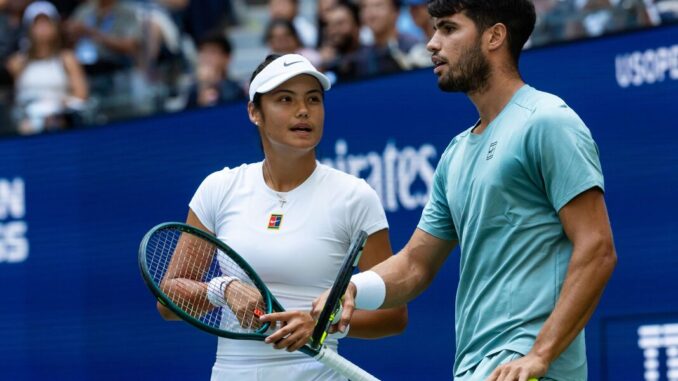
The 2025 US Open at Flushing Meadows delivered a thrilling spectacle, crowned by Carlos Alcaraz’s pulsating victory over Jannik Sinner in a final that showcased the future of tennis. Yet, beneath the surface of the Spaniard’s triumph and the broader tournament narrative, a storm of fan reactions and logistical critiques has emerged, with Emma Raducanu’s early exit and Alcaraz’s heroics fueling heated discussions. The tournament, while a showcase of elite talent, has been tasked with addressing fan discontent and operational hurdles to maintain its status as a Grand Slam pinnacle.
Carlos Alcaraz, the 22-year-old prodigy, reclaimed the US Open title and the world No. 1 ranking with a hard-fought win over Sinner, highlighted by a breathtaking baseline overhead that left spectators in awe. “One of the greatest baseline overheads you’ll see,” commentators raved, capturing the moment Alcaraz ignited the New York crowd. The third set saw him surge back, taking it 6-1 after dropping the second, ultimately sealing the match to claim his third US Open crown. His victory, however, wasn’t without controversy. Some fans, vocal on social platforms, argued Alcaraz benefited from a favorable draw, with one user noting, “Carlos had a clear path compared to Sinner’s gauntlet.” Others hailed his resilience, pointing to his 6-2 opening set and spirited third-set comeback as evidence of his greatness. “He takes the third set 6-1 and closes in on the title,” one post celebrated, reflecting the polarized sentiment surrounding his performance.
Emma Raducanu, Britain’s 2021 champion, faced a different narrative. Her first-round loss to American Danielle Collins, ranked No. 11, reignited debates about her consistency. The 6-4, 6-3 defeat was a blow for the 22-year-old, who admitted, “I think I’m playing good tennis, but it’s a very fine line at this level.” Fans were split: some expressed frustration, with one commenting, “Raducanu needs to step up or she’ll stay a one-Slam wonder,” while others defended her, citing her recent recovery from injury and her 3.5 million social media followers as proof of her enduring appeal. Her decision to skip the Billie Jean King Cup Finals to focus on the Asian swing, including the Korea Open, drew further scrutiny, though her former coach Mark Petchey backed her choice. “There’s always two sides to everything,” Petchey said, highlighting her 3-0 singles record in last year’s BJK Cup as proof of her commitment.
Beyond the players, the US Open itself faced criticism. Fans lamented the atmosphere at Arthur Ashe Stadium, with one observer noting, “Ashe used to be electric during big matches.” High ticket prices were a sore point, reportedly pricing out dedicated tennis fans and leading to empty seats during key matches, including the semi-finals. “US Open has really priced out tennis fans and it’s led to bad crowds all tournament,” one post complained, pointing to a disengaged audience despite packed stands for Alcaraz’s final. The tournament’s scheduling also drew ire, with late-night matches stretching past midnight, alienating viewers and players alike. Suggestions for improvement included dynamic pricing to fill seats and scheduling tweaks to avoid late finishes, with one fan proposing, “They need to cap ticket prices or offer last-minute deals to get real fans in.”
The women’s tournament, won by Aryna Sabalenka over Jessica Pegula, also highlighted competitive depth but underscored logistical issues. Sabalenka’s powerful performance contrasted with Pegula’s gritty run, yet the narrative around Raducanu’s exit dominated discussions. Her loss to Collins, who later fell to Jaqueline Cristian, highlighted the fine margins at this level. “It’s a very fine line,” Raducanu reiterated, reflecting on the need for precision against top players like Iga Swiatek or Krejcikova, whom she might face in Seoul.
Alcaraz’s victory, while a triumph, couldn’t fully overshadow the tournament’s challenges. Posts noted the “low energy” crowd, a stark contrast to the raucous support during his third-set surge, where he led 3-0 and rallied the New York faithful. “Carlos Alcaraz wants to hear you, New York!” one update exclaimed, capturing his ability to energize fans despite broader disengagement. His win over Sinner, who took a set off him, was a testament to his mental fortitude, but fans debated whether his draw—avoiding early clashes with players like Novak Djokovic—flattered his path.
As the US Open reflects on 2025, the tournament faces a clear mandate: reconnect with its core audience. Proposals include better crowd management, affordable seating options, and a scheduling overhaul to enhance player and fan experiences. For Raducanu, the focus shifts to Asia, where a tough Korea Open draw awaits, including potential clashes with Wimbledon champions Krejcikova and Swiatek. “It does give me confidence because the problem before was I felt I was gulfs away,” she said, signaling her intent to bridge the gap. Alcaraz, meanwhile, basks in his latest triumph, but the divided fanbase—some calling him “overrated,” others “unstoppable”—ensures his journey remains under scrutiny.
The 2025 US Open was a tale of brilliance and blemishes. Alcaraz and Raducanu, two of tennis’s brightest stars, embody its highs and lows, captivating fans while exposing the tournament’s growing pains. With work to do, Flushing Meadows must evolve to keep its magic alive.
Leave a Reply